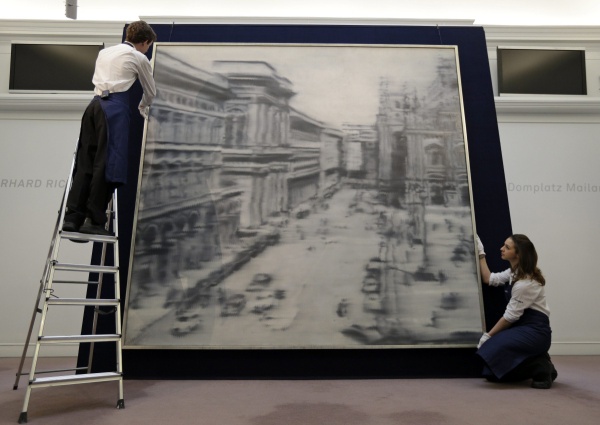
More thoughts on the Germans. Gerhard Richter is by far the leader in the top ten most expensive living German artists. But even leaving Richter aside, German art, particularly painting, is experiencing a dramatic upsurge in popularity among international collectors. Alexander Forbes writing for Artnet News in April 2014 reported that the power of German art in the market has actually increased since the 2008 recession. There is no sign of it slowing down. Richter himself believes the market for art generally, and for his own art in particular, has gone crazy. Richter criticizes the art market.
Forbes suggests that German art’s penchant for “stringent conceptualism and a highly art historical approach likely proves a safe bet for value retention regardless of economic conditions.
I want to hold that idea. It suggests that art which reflects both conceptual thought – a philosophical element – as well as an embedded engagement with history is likely to hold its value best. On this analysis the German art market is likely to continue to ever higher peaks.
Richter’s mysterious Domplatz, Mailand (Cathedral Square, Milan) painted in 1968 during the height of his blurred monochrome period sold recently for $37,125,000 at Sotheby’s 2013 contemporary art sale. His paintings hold the first 53 places on the top achieving auction sales of German art, 33 achieving over $10 million.

The range of Richter’s work is astonishing. Probably best known for his “blurred monochromes” of the 1960s, his abstract works have also taken on a special aura of mystery, seeming to move away from figuration and narrative completely. You really need to read Richter’s own writings (which are extensive) to get an idea of what he is thinking in this strand of his work, which seemingly just gets better and better. Cage 5, 2006, (below) is a vastly large oil painting reflecting back on his early vision, yet imbued with endless hints and depths of experience which could be landscape or water-surface or a close-up of a lot of brushstrokes – something he also explored in the 1980s. But he invites us to think of a cage, and that opens up a whole different set of associations.

The sheer scale of Richter’s work is entrancing, but so is the sense of our shared collective history, that mid-twentieth century Europe with its horrors and excesses which he opens up to us from the 1960s on. Neo Rauch, my second favourite German artist, does the same, although it a totally different way. You can read my academic article on Neo Rauch here.Neo Rauch Post Socialist Vision, Collective Memories
It is overwhelming in so many ways to enter the Richterian world. Fortunately it is also easy, as Richter’s own website is an absolute miracle of clarity, order and revelation. You can find (almost) anything he has ever done there, complete with full references, links to written and audio discussions and interviews, the ability to zoom in onto details, and the complete presentation of his Atlas project, which really is no more than a full record of every image he has collected (or photographed) in his life. Explore the miracle of Richter’s work here.
Unbelievably there is almost nothing of Richter’s art in pubic collections in Australia. The AGNSW at least made some effort and holds three items, a painted monochrome sphere from 1989, a photograph from 1967, and his strange version of a nude descending a staircase, titled Ema, from 1992.
The Art Gallery of South Australia holds one of his luminous abstracts (Abstraktes Bild) from 1977 (Catalogue Raisonne: 424). * (Eric Clapton sold another in the Abstraktes Bild series for 21.3 million British pounds in 2013). One of Richter’s finest 1990’s abstracts CR:752-3, 1990, 225 x 200cm) is held in the National Gallery of Victoria in Melbourne, purchased with corporate funding assistance from Westpac Bank, and the NGA in 2003 purchased Juno, oil on canvas 300 x 250 (NGA 2004.2).Richter’s 1995 Abstract at the NGV

Gerhard Richter’s work is now so valuable that there will be little or no opportunity to ever acquire it in Australia. Should public collections in Australia be more open to contemporary work from outside Australia? Why German artists, and not those from Romania, Holland, or wherever? Should we just focus on local art and artists and make a kind of nationalist stand? This might be a valid position but when you consider the extent of Australian gallery holdings of recent American and UK artists you just cannot help but conclude that the good old neo-colonial world order underpins every level of public culture, including public art. Sensible use of public assets or parochialism and subservience to a highly limited Anglophone culture sphere?
*Strangely though this rare work hardly features on the Gallery’s site. No image of it is available there. It has been shown only once in public as part of the exhibition “Making Nature: Masters of Early European Landscape Art” (June-September 2009). Why it was included in that collection is a mystery as Richter can hardly be considered “early” and this painting is very far from one of his landscapes. An image of it is available on Richter’s website – just click on the “Abstracts” collection with the CR number 424.
